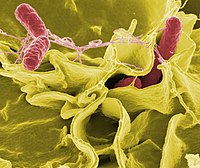
Photo from wikipedia
Enterococcus cecorum is an emerging avian pathogen, particularly in chickens, but can be found in both diseased (clinical) and healthy (non-clinical) poultry. To better define differences between E. cecorum from… Click to show full abstract
Enterococcus cecorum is an emerging avian pathogen, particularly in chickens, but can be found in both diseased (clinical) and healthy (non-clinical) poultry. To better define differences between E. cecorum from the two groups, whole-genome sequencing (WGS) was used to identify and compare antimicrobial resistance genes as well as the pan-genome among the isolates. Eighteen strains selected from our previous study were subjected to WGS using Illumina MiSeq and comparatively analyzed. Assembled contigs were analyzed for resistance genes using ARG-ANNOT. Resistance to erythromycin was mediated by ermB, ermG, and mefA, in clinical isolates and ermB and mefA, in non-clinical isolates. Lincomycin resistance genes were identified as linB, lnuB, lnuC, and lnuD with lnuD found only in non-clinical E. cecorum; however, lnuB and linB were found in only one clinical isolate. For both groups of isolates, kanamycin resistance was mediated by aph3-III, while tetracycline resistance was conferred by tetM, tetO, and tetL. No mutations or known resistance genes were found for isolates resistant to either linezolid or chloramphenicol, suggesting possible new mechanisms of resistance to these drugs. A comparison of WGS results confirmed that non-clinical isolates contained more resistance genes than clinical isolates. The pan-genome of clinical and non-clinical isolates resulted in 3651 and 4950 gene families, respectively, whereas the core gene sets were comprised of 1559 and 1534 gene families in clinical and non-clinical isolates, respectively. Unique genes were found more frequently in non-clinical isolates than clinical. Phylogenetic analysis of the isolates and all the available complete and draft genomes showed no correlation between healthy and diseased poultry. Additional genomic comparison is required to elucidate genetic factors in E. cecorum that contribute to disease in poultry.
Journal Title: Foods
Year Published: 2020
Link to full text (if available)
Share on Social Media: Sign Up to like & get
recommendations!